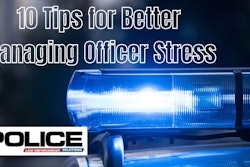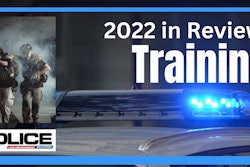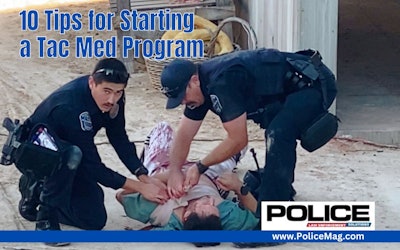 Officers are placed in a training scenerio as part of a tactical medicine program at the Hawthorne Police Department.PHOTO: Hawthorne Police Department/POLICE Illustration
Officers are placed in a training scenerio as part of a tactical medicine program at the Hawthorne Police Department.PHOTO: Hawthorne Police Department/POLICE Illustration
The ability to render life-saving measures to fellow officers can increase their chances of survival. Departments can choose how much training their officers receive, whether that be through additional first aid training or even creating a tactical medicine program.
Dr. Joe Nakagawa, an emergency room doctor in southern California, was among area physicians invited to get involved with the local SWAT team about 15 years ago. That led him along a path to becoming a reserve officer and finally stepping away from his fulltime role as a doctor to become a fulltime police officer. Now as medical director, he leads the tactical medicine program at the Hawthorne Police Department.
“Tactical medicine is different, depending on who you ask. But for me, tactical medicine is really first aid but in a tactical setting so you don't get yourself hurt, you don't get anybody else hurt, and you're looking at the big picture as part of a police operation rather than just providing the medical care,” Nakagawa says.
So, why should a department start a tac med program to train its officers?
“First and foremost, it's about officer safety. The guys have a dangerous job and traditionally they haven't been given the tools and the training they need to protect themselves and their friends, their partners, when they get hurt,” says Nakagawa.
Past the officer safety considerations, there are additional advantages for departments that implement tac med training to expand on officers’ abilities to render aid.
“What we found recently is this is a huge public relations win for most police departments. The public just hears the negative narrative from the mainstream media, but I think people need to see that police officers are out there doing all kinds of good work, saving lives, CPR, first aid, tourniquets, Narcan. They're saving far more lives than anything else,” explains Nakagawa. “So those are two big reasons to start a tactical medicine program.”
Nakagawa, both as a cop and a doctor, says medical training is something any size department can do. The Hawthorne Police Department has about 100 sworn officers and all are trained through the department’s tac med program. However, police academies in California prepare recruits to handle many medical emergencies on the street.
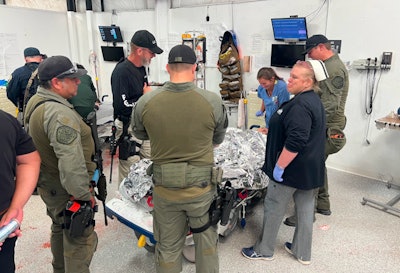 Officers learn to provide better medical care for when they are in the field.PHOTO: Hawthorne Police Department
Officers learn to provide better medical care for when they are in the field.PHOTO: Hawthorne Police Department
“We've pushed tactical medicine to be put in the academies and so now what they're getting in the academy is pretty advanced compared to what it was 20 years ago. They're taught how to put on tourniquets, chest seals, nasal airways, Narcan; so fairly high level stuff for a brand new police officer,” he says.
In California, Title 22 outlines what medical skills a first responder has at their disposal for firefighters, lifeguards, and police officers. Nakagawa says that level of training is about 90% of the scope of practice of an EMT. But, if you train past that California Title 22 level or equivalent, more guidance is needed.
Starting a program to provide increased training for officers to handle medical emergencies is not necessarily like starting from scratch if a department reaches out to agencies they already know.
“If you have a close relationship with the fire department in your city, sometimes you can come up with an MOU to cross train and actually be covered under their policies and procedures and be affiliated with them,” he points out.
But that other agency need not necessarily be a fire department.
It could be another police department with an established tac med program. That is the case with the Hawthorne Police Department, an agency that provides medical oversight for four other departments through contracts. With that, Nakagawa is medical director for five departments now.
If officers are trained in the academy with some advanced first aid, then issuing them tourniquets, coming up with some departmental policies and procedures, and providing regular training is enough to start a tac med program points out Nakagawa.
“From there, you can scale it up to much bigger things such as having a fulltime tactical medicine team that supports tactical cooperations and whatnot,” he says. “It's really dependent on the needs of the department.”
If a department wants to launch a tac med program, there is always a way and Nakagawa has 10 suggestions to help you get started. Those are:
1. Have a Plan
Failing to plan is planning to fail. Before or during any operation, consider the medical aspects. These can include tactical response from medics, transport of casualties, rescue task forces, casualty collection points, etc. Without having a plan for the injured, their care will suffer and it will cause problems for the mission at hand.
2. Work with EMS Partners
Establish a close relationship with EMS. They, at some point, will be taking all of your casualties. They will also be responding with you on many calls. Know the names and faces before an incident and train with them so everyone is on the same page. Sometimes it is like getting cats and dogs together but when the big one happens, the return on investment is immeasurable.
3. Consider Training LE
We tried taking fire medics and training them up to be cops but we’ve had better luck with training our cops to be medics. Ninety-nine percent of the time, nothing medical happens and they handle the LE responsibilities. They also understand police operations and priorities and don’t need a protection detail. Also, supervision and control of the medics all stays under one roof, making training and scheduling easier.
4. Don’t Confine it to SWAT
We started with tactical medics on SWAT but found that almost all medical interventions happen on patrol. Train everyone to a minimum standard of the civilian equivalent of tactical combat casualty care (TCCC) and equip them to use those skills. Having everyone able to do something is better than having one person who can do everything.
5. Change the Culture
Most cops did not go into law enforcement to provide medical treatment. Initially, we had some pushback from those who thought that cops do cop stuff and EMS does EMS stuff and there should be no crossover. However, over time, we have changed the outlook and now our officers are super aggressive with field treatment. Unless the line level believes in the mission, they will never start doing medical.
6. Replace Equipment
When we started out, some of our officers were reluctant to use their issued gear on victims and
suspects since they wanted to save it for themselves or their partners. More than once, they used field improvised tourniquets instead of their issued tourniquets. Make sure they know that their gear will be replaced if used so they are not hesitant to use it.
7. Don’t Make More Work
Everyone is already busy with the increasing documentation and procedural requirements of being a cop. Having more forms and more reports is a sure way to slow adoption of cops performing medical treatments. Though care does need to be documented, make it seamless and painless.
8. Recognize Good Work.
Let everyone know when someone has a good save. These can serve as learning cases as well as reinforcing your department’s belief in providing medical care. We have in-house awards as well as regional award ceremonies to recognize them. We also post bodycam footage on an Instagram feed to show the public that cops are out there saving lives, not just taking them. We need to counter the mainstream narrative that critics are peddling.
9. Don’t Reinvent the Wheel
At this point, there is a huge body of knowledge out there on tactical medicine and LE-based programs. Every department has different needs, but the basics are all the same. Work with local partners who have a program or are in the process of implementing one and save yourself some work.
10. Stay Balanced
While our original issues were trying to get cops to perform medical interventions on victims, we now have the opposite problem. They are so enthusiastic and aggressive with the medical that they sometimes compromise the safety or investigative aspects of patrol. Make sure they understand that they are cops first and find that balance so that they can save lives without unduly risking themselves or others and fulfill their law enforcement responsibilities.
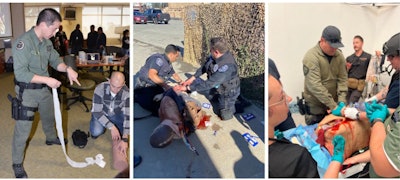 Tac med training can be done in a variety of environments and formats.PHOTO: Hawthorne Police Department
Tac med training can be done in a variety of environments and formats.PHOTO: Hawthorne Police Department






